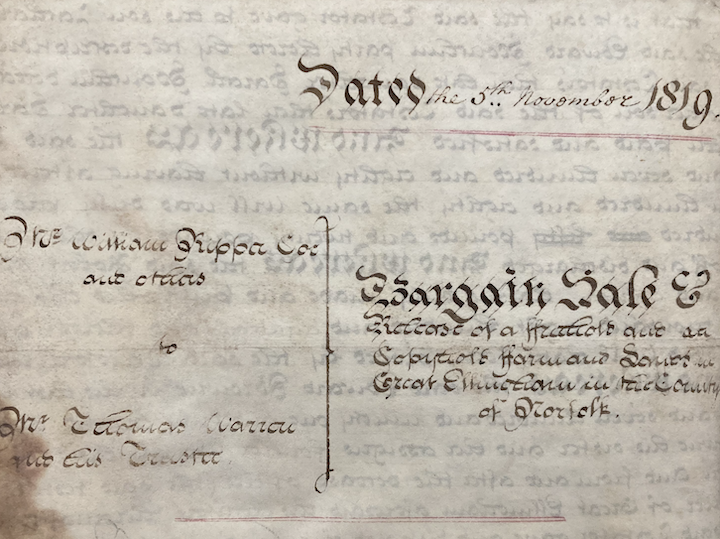
Extract from the Indenture of Bargain & Sale 5 November 1819
William Ripper Coe & Others to Thomas Warren & his Trustee
Courtesy David & Julia Matthews
From 1724 to at least 1819, the Browne family owned and occupied a farm at the northern end of Long Street. Much later, the farm became known as ‘Broadmarsh Farm’.
For ease of reference, I refer to the farm as ‘Broadmarsh Farm’ whether or not the farm was known by the name at that time.
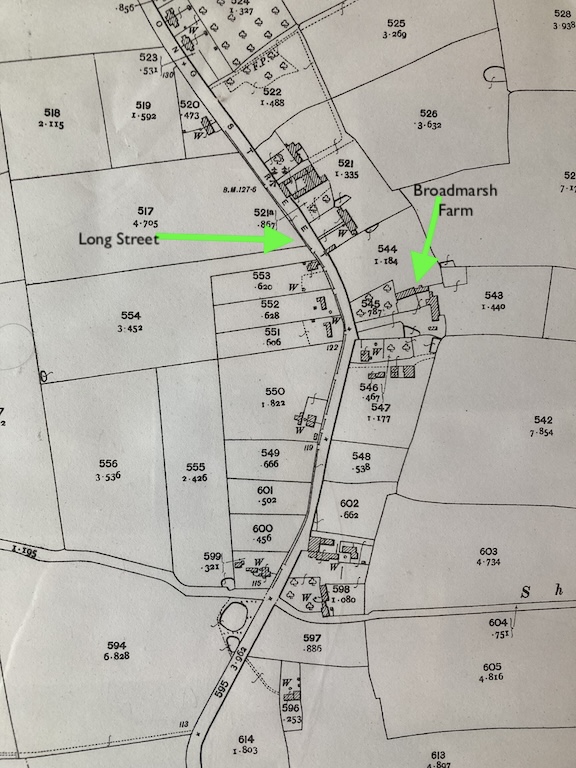
Extract from 1906 Ordnance Survey Map. Second Edition. Surveyed in 1881. Revised 1904
Zachariah Browne purchased Broadmarsh Farm in 1724. When he died in 1780, Zachariah left the farm to his daughter Hannah and son Edward as ‘tenants in common’. This meant that on the death of either of them, the survivor would not automatically inherit the deceased’s share in the farm. Instead, the ownership would pass in accordance with the deceased’s will.
Edward Browne’s Will
On the 16th February, 1791, Edward Browne hurriedly signed his last will and testament. Just six days later, he was buried in St James’s churchyard.
What may have been as a huge relief to Hannah, Edward gave her a life interest in his half-share of the farm. This meant that Hannah could continue to live in and run the farm.
In addition, Edward Browne left various legacies. However, these would only be paid after Hannah’s death from the proceeds of the sale of Edward’s share in the property. As it happens, Edward’s will was defective. He omitted to leave instructions as to who would inherit his residuary estate (i.e. the rest of his estate once any debts and legacies had been paid).
Hannah Buys Edward’s Share
Nevertheless, Hannah purchased her late brother’s share in the farm. She also agreed to include provision in her will to settle her late brother’s legacies.
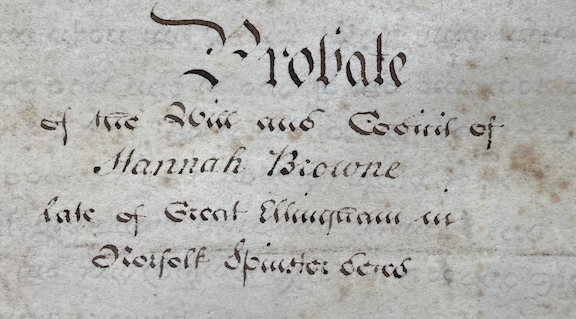
18 May 1819. Extract from the Probate of the Will of Hannah Browne
Courtesy David & Julia Matthews
Hannah died at the age of 79 on the 8th August, 1818. As a consequence, Broadmarsh Farm is to be sold.
Auction
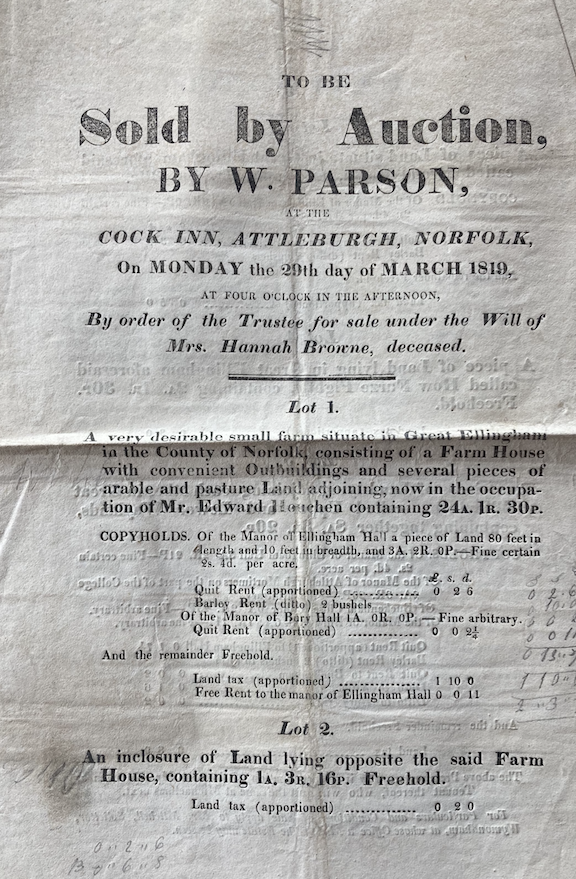
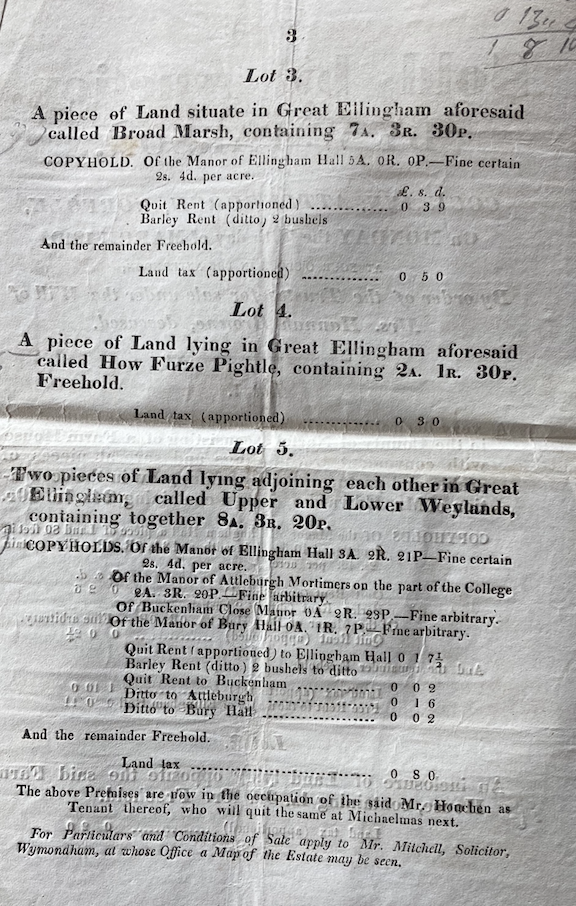
Extract from the Auction Particulars & Conditions of Sale. 29th March 1819. Courtesy David & Julia Matthews
At the time of the auction, the property was occupied by Hannah Browne’s nephew, Eddy (Edward) Houchen.
Nonetheless, arrangements were made for the farm to be included in the auction held on the 29th March, 1819, at the Cock Inn in the nearby town of Attleburgh (Attleborough).
Highest Bidder
It was, in fact, Eddy Houchen who successfully bid for the farm at the sum of £1,040. However, the purchase did not include the land referred to as ‘Broad Marsh’ in Lot 3.
Nevertheless, it transpires that Eddy Houchen consequently agreed to sell the farm to local Great Ellingham farmer, Thomas Warren.
Thomas Warren
On the 5th November, 1819, Thomas Warren completed his purchase of the farm from the surviving executor of Hannah Browne. The purchase price amounted to £1,080. In accordance with his agreement with Eddy Houchen, Warren paid £40 to Eddy Houchen and £1,040 to William Ripper Coe, the late Hannah Browne’s surviving executor.
The conveyance deed describes the property as “all that messuage or tenement with the houses barns stables buildings yards orchards gardens and homestalls to the same belonging ….”. The purchase also included several parcels of land.
Broad Marsh
On the very same day, Zachariah Browne, a tailor of Upwell, purchased the land referred to at the auction as Lot 3. Zachariah Browne is a grandson of the late Hannah Browne’s eldest brother, Zachariah.
Nevertheless, on the 15th September, 1826, Browne sold ‘Broad Marsh’ to Thomas Warren for £260. This land comprised both freehold and copyhold parts. It had recently been ‘occupied’ by local man, John Robert Barnard.
It was during the early part of the 20th century, that the farm would become known as ‘Broadmarsh Farm’. Likely the name ‘Broadmarsh’ came from the old field name of ‘Broad Marsh’, which is also recorded as ‘Bredmersh’.
Islay House
I do not believe that Thomas Warren ever occupied Broadmarsh Farm.

Islay House in Church Street. The former home of William & Frances Kiddle and then Thomas & Jane Warren
Courtesy Charles Mason
At the time Warren purchased the farm, he and his wife, Frances Jane (known as Jane), lived at the house in Church Street which, much later, became known as Islay House. Again, I refer to this property as ‘Islay House’ whether or not it was known by that name at the time.
Islay House had been Jane Warren’s family home. She inherited the house in 1818 following the death of her mother, Frances Kiddle. Jane’s father, William Kiddle died in 1816.
Occupier William Downes
I am unclear as to who occupied the farm at the time of Thomas Warren’s purchase. Nevertheless, by the 1830s, William Downes is living at Broadmarsh Farm.
The 1841 census captures farmer William Downes and his wife Elizabeth in Great Ellingham. They are both said to be aged 65. However, William was then around the age of 68 and his wife 63.
With the couple are 15 year old female servant Mary Denny and five year old James Denny. They are likely the children of William and Elizabeth’s daughter Ann, who married John Denny. Also with the household is 15 year old male servant Jeremiah Edwards.
The Great Ellingham Tithe Map of 16th December, 1843, shows that William Downes is still occupying Broadmarsh Farm. However, Sarah Pooley is also living there. Nevertheless, I do not know whether she is living in the farmhouse with William and Elizabeth Downes or occupying another dwelling or tenement on the farm.
Occupier Sarah Pooley
In 1841, 90 year old Sarah Pooley is living alone near to or in Church Street. She died in April 1845 and was buried in the churchyard of St James.
William Downes’ Tenure comes to an End
Between 1843 and 1845, William and Elizabeth Downes moved out of Broadmarsh Farm. They are now at Islay House in Church Street. The owner, Thomas Warren, had relocated to Norwich.
In 1845, Islay House was sold to Henry Pettitt. Nevertheless, Thomas Warren retained the ownership of Broadmarsh Farm.
Unfortunately, I do not know who occupied Broadmarsh Farm immediately after William Downes. However, I do know that prior to 1856, Broadmarsh Farm was occupied by John Day.
Death of Thomas Warren
On the 21st November, 1856, Thomas Warren signed his last will and testament. On his death, Broadmarsh Farm would pass to his grandson, Jeremiah Warren.
Thomas Warren died two years later. Subsequently, the ownership of Broadmarsh Farm passed to Jeremiah Warren.
Occupier Day, Dey, Dye
In his will, Thomas Warren refers to Broadmarsh Farm as “… my messuage or farmhouse and lands situate and being in Great Ellingham and now in the occupation of John Day …..”
I believe the reference to John Day is indeed John Dye. The name ‘Dye’ is sometimes found in records as ‘Dey’.
The 1861 census finds 38 year old John Dye with his 34 year old wife Susannah living in Long Street. John Dye is farming some 40 acres and employing one man.
At the time of the census, the couple have 5 children. Sophia 13, Mary Ann 8, James 6, Matilda 4 and two year old John Joseph. Ten years earlier, John and Susanna Dye were living with Susanna’s uncle and aunt, John and Susanna Ayers, at Bush Green.

1858 Extract from Inland Revenue Succession Duty
Courtesy David & Julia Matthews
John Dye’s tenure of Broadmarsh Farm was at a yearly rent of £58. However, by 1863, the Dye family had vacated the farm.
Accordingly, Broadmarsh Farm (now owned by Jeremiah Warren), would have new occupiers.
Sources:
Private Property Deeds. Thanks to David & Julia Matthews
Great Ellingham Parish Registers. Norfolk Record Office PD 609. Also available via familysearch.org, www.ancestry.co.uk & other subscription websites
1799-1842 F W Horner, Records of the Surveyors to Commissioners for Inclosure in Parishes in Norfolk and Suffolk. Great Ellingham (Act 1799). Norfolk Record Office. Catalogue Ref: NRO, BR 90/2
1841 census HO107/781/8
1851 census HO107/1823/122
1861 census RG9/1237/94
16 December 1843. Great Ellingham Tithe Map. Tithe Apportionments, 1836-1929 [database online]. TheGenealogist.co.uk 2025. Original data: “IR29 Tithe Commission and successors: Tithe Apportionments” The National Archives.
Norfolk, England, Register of Electors, 1832-1915. Ancestry.com. Norfolk, England, Register of Electors, 1832-1915 [database on-line]. Lehi, UT, USA: Ancestry.com Operations, Inc., 2016. Original data: England, Norfolk Register of Electors, 1844-1952. Salt Lake City, Utah: FamilySearch, 2013.